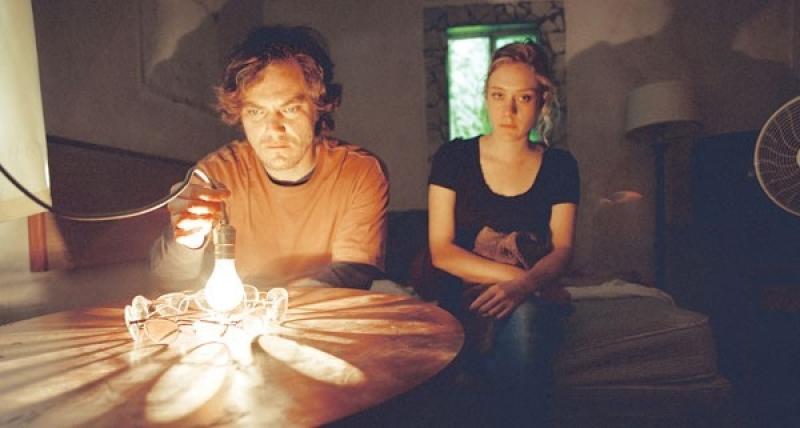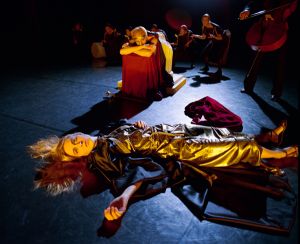My Son, My Son, What Have Ye Done | reviews, news & interviews
My Son, My Son, What Have Ye Done
My Son, My Son, What Have Ye Done
Herzog's slight though memorable portrait of an obsessive

For 15 years after the death of his demon muse Klaus Kinski, Werner Herzog made documentaries about equally obsessive visionaries, climaxing five years ago with Grizzly Man’s tale of Timothy Treadwell, who loved and was eaten by bears. Though the documentaries continue, Herzog is now finally re-engaging with feature films.
Brad Macallum (Michael Shannon) is Herzog’s latest one-man warrior against civilisation, holed up in a flamingo-infested San Diego house on the morning we meet him, having run his mother through with a samurai sword. As a clueless detective (Willem Dafoe), Brad’s girlfriend (Chloe Sevigny, pictured below) and Udo Kier as his director in a production of Euripides’s Orestes - in the title role of which Brad murders his mother - wait outside, they piece together the events that led him here.
 Herzog again turned to fact for inspiration: in 1979, Mark Yavorsky killed his mother in San Diego after rehearsing Orestes, though when the director visited him in the late Nineties and found that Yavorsky had built a rough shrine to his film Aguirre, Wrath of God and was still dangerously psychotic, he abandoned any documentary intentions. Shannon (Oscar-nominated for Revolutionary Road and also impressive this week as The Runaways’ monstrous manager Kim Fowley), with his heavy brow and hooded, sleepless eyes, makes Brad a lupine Manson figure, a bomb ticking ever louder to an internal logic.
Herzog again turned to fact for inspiration: in 1979, Mark Yavorsky killed his mother in San Diego after rehearsing Orestes, though when the director visited him in the late Nineties and found that Yavorsky had built a rough shrine to his film Aguirre, Wrath of God and was still dangerously psychotic, he abandoned any documentary intentions. Shannon (Oscar-nominated for Revolutionary Road and also impressive this week as The Runaways’ monstrous manager Kim Fowley), with his heavy brow and hooded, sleepless eyes, makes Brad a lupine Manson figure, a bomb ticking ever louder to an internal logic.
But unless you read Herzog’s film as a portrayal of the artificial and unconvincing world as Brad comes to see it, there’s little pretence at reality or conventional emotional engagement here. Other characters’ stilted speech sounds as if they’re in a play, or a cheap B-movie. Despite Lynch’s involvement, this isn’t one of his broken, impenetrable puzzles, but a perfectly explicable story, marked by Herzog’s interest in place, stillness and discomfort. A silence between Brad, his girlfriend and his oppressive mother (Grace Zabriskie) holds long enough to evolve from awkward to insane, Zabriskie’s mouth twitching from the social pressure’s G-force.
Like Dennis Hopper’s later, compromised films as director, much of the pleasure lies in the odd actors and scenes Herzog assembles on the margins. Sevigny (seeming both innocent and jaded), Warhol cult star Kier, and Brad Dourif’s Uncle Ted, proprietor of the OK Corral Ostrich Farm and a man with a healthy fear of Greek plays and the nation that made them (“I had to lock my sheep up at night, they got so nervous,” he reminisces darkly of a Greek neighbour), are all slyly entertaining.
Herzog’s is a crepuscular California, shot in high contrast, showing bleached light or the black recesses of old people’s homes at midday. He also returns to the Peruvian jungle where he infamously trekked for both Aguirre and Fitzcarraldo, and Brad has his epiphany after abandoning his friends to a foolish kayaking trip where they all die. We also glimpse Tijuana’s seething borderland, Calgary’s weird glass corridors, and staring Mongolian peasantry, frustrating fragments of Herzog films that never were. The shot of Shannon’s Brad leaning his head far back on a rock, as Peru’s most deadly river rushes muddily behind him, is the most powerful in a finally slight though memorable film. Herzog the reborn fiction-maker remains a documentarian at heart.
Watch the My Son, My Son, What Have Ye Done trailer
Explore topics
Share this article
The future of Arts Journalism
You can stop theartsdesk.com closing!
We urgently need financing to survive. Our fundraising drive has thus far raised £49,000 but we need to reach £100,000 or we will be forced to close. Please contribute here: https://gofund.me/c3f6033d
And if you can forward this information to anyone who might assist, we’d be grateful.

Subscribe to theartsdesk.com
Thank you for continuing to read our work on theartsdesk.com. For unlimited access to every article in its entirety, including our archive of more than 15,000 pieces, we're asking for £5 per month or £40 per year. We feel it's a very good deal, and hope you do too.
To take a subscription now simply click here.
And if you're looking for that extra gift for a friend or family member, why not treat them to a theartsdesk.com gift subscription?
more Film
 London Film Festival - from paranoia in Brazil and Iran, to light relief in New York and Tuscany
'Jay Kelly' disappoints, 'It Was Just an Accident' doesn't
London Film Festival - from paranoia in Brazil and Iran, to light relief in New York and Tuscany
'Jay Kelly' disappoints, 'It Was Just an Accident' doesn't
 Iron Ladies review - working-class heroines of the Miners' Strike
Documentary salutes the staunch women who fought Thatcher's pit closures
Iron Ladies review - working-class heroines of the Miners' Strike
Documentary salutes the staunch women who fought Thatcher's pit closures
 Blu-ray: The Man in the White Suit
Ealing Studios' prescient black comedy, as sharp as ever
Blu-ray: The Man in the White Suit
Ealing Studios' prescient black comedy, as sharp as ever
 The Woman in Cabin 10 review - Scandi noir meets Agatha Christie on a superyacht
Reason goes overboard on a seagoing mystery thriller
The Woman in Cabin 10 review - Scandi noir meets Agatha Christie on a superyacht
Reason goes overboard on a seagoing mystery thriller
 London Film Festival 2025 - crime, punishment, pop stars and shrinks
Daniel Craig investigates, Jodie Foster speaks French and Colin Farrell has a gambling habit
London Film Festival 2025 - crime, punishment, pop stars and shrinks
Daniel Craig investigates, Jodie Foster speaks French and Colin Farrell has a gambling habit
 I Swear review - taking stock of Tourette's
A sharp and moving tale of cuss-words and tics
I Swear review - taking stock of Tourette's
A sharp and moving tale of cuss-words and tics
 A House of Dynamite review - the final countdown
Kathryn Bigelow's cautionary tale sets the nuclear clock ticking again
A House of Dynamite review - the final countdown
Kathryn Bigelow's cautionary tale sets the nuclear clock ticking again
 theartsdesk Q&A: Idris Elba on playing a US President faced with a missile crisis in 'A House of Dynamite'
The star talks about Presidential decision-making when millions of lives are imperilled
theartsdesk Q&A: Idris Elba on playing a US President faced with a missile crisis in 'A House of Dynamite'
The star talks about Presidential decision-making when millions of lives are imperilled
 Urchin review - superb homeless drama
Frank Dillane gives a star-making turn in Harris Dickinson’s impressive directorial debut
Urchin review - superb homeless drama
Frank Dillane gives a star-making turn in Harris Dickinson’s impressive directorial debut
 Mr Blake at Your Service review - John Malkovich in unlikely role as an English butler
Weird comedy directed by novelist Gilles Legardinier
Mr Blake at Your Service review - John Malkovich in unlikely role as an English butler
Weird comedy directed by novelist Gilles Legardinier
 Don't Let's Go to the Dogs Tonight review - vivid adaptation of a memoir about a Rhodesian childhood
Embeth Davidtz delivers an impressive directing debut and an exceptional child star
Don't Let's Go to the Dogs Tonight review - vivid adaptation of a memoir about a Rhodesian childhood
Embeth Davidtz delivers an impressive directing debut and an exceptional child star

Add comment